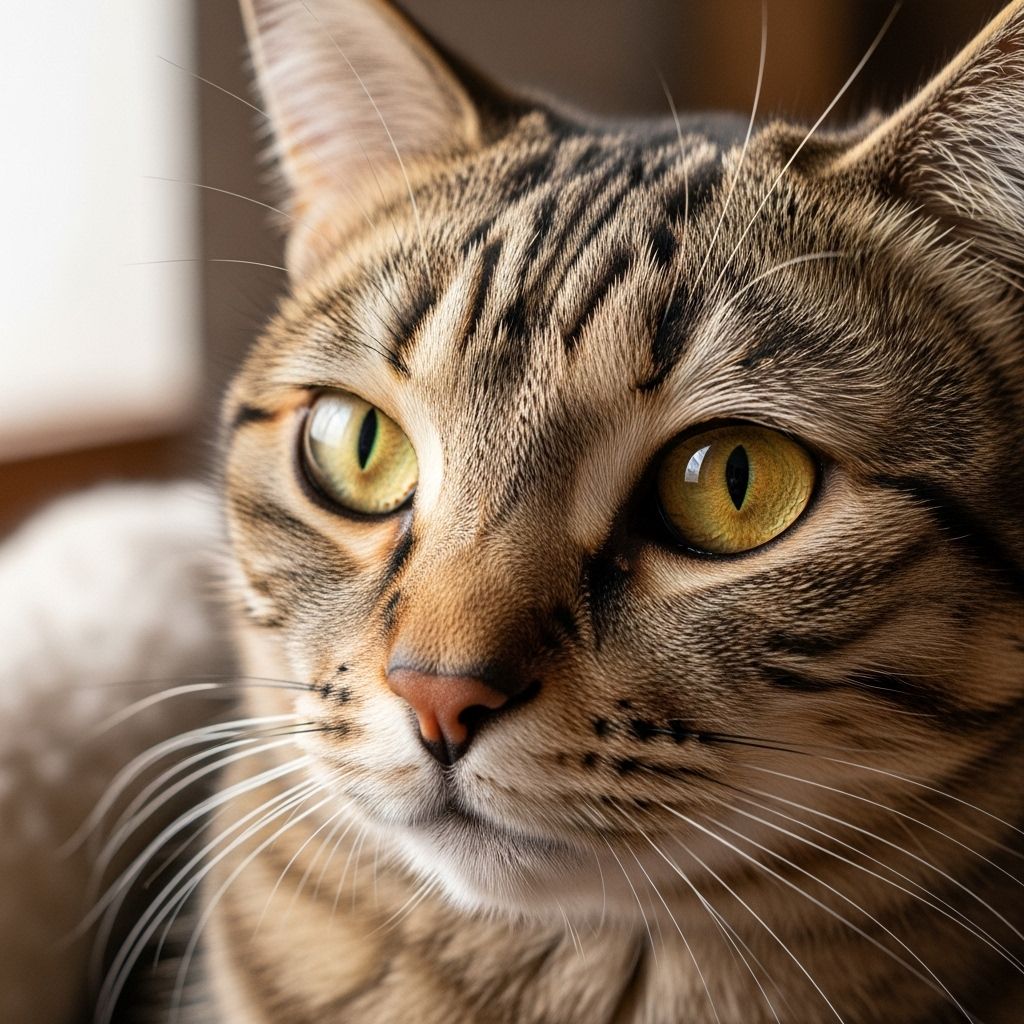Understanding Cat Behavior Changes: Causes, Signs, and Solutions
Spot subtle mood shifts and build a calmer, more secure life for your feline companion.

Cat owners often notice that their feline companions don’t always act the same way throughout their lives. While sudden or subtle changes in behavior can be a normal part of feline development, they can also signal underlying medical problems, stress, or age-related conditions. This comprehensive guide helps you identify, understand, and address cat behavior changes—so you can promote your cat’s lifelong health, happiness, and your deep bond together.
Why Do Cats Change Their Behavior?
Cats are creatures of habit, but like all animals, their behaviors may evolve in response to health status, emotional well-being, aging, or changes in the environment. Understanding the potential reasons behind these changes is the first step in providing the best care for your feline companion.
- Physical health: Pain, illness, or sensory decline can alter mood and activity level.
- Emotional state: Anxiety, stress, boredom, or trauma can disrupt normal behaviors.
- Cognitive function: Memory and learning difficulties may appear as cats age.
- Social factors: New people or pets, moving homes, or changes in household dynamics can trigger behavioral adjustments.
Common Signs of Cat Behavior Changes
Detecting early changes in your cat’s conduct is crucial. Here are common signs that may indicate your cat is experiencing physical discomfort, emotional stress, or cognitive decline:
- Altered interaction: Becoming more clingy or withdrawn, avoiding people or pets, or hiding more often.
- Changes in litter box habits: Forgetting trained behaviors, urinating or defecating outside the box, or associating the box with pain.
- Excessive vocalization: More frequent or louder meowing, particularly at night.
- House soiling and spraying: Marking areas with urine or feces outside the litter box.
- Altered sleep patterns: Increased daytime sleeping and restlessness or activity at night.
- Changes in grooming: Over-grooming (leading to bald patches) or neglecting grooming.
- Appetite changes: Loss of interest in food or drinking more/less water.
- Repetitive or compulsive behaviors: Pacing, over-scratching, or abnormal vocalizations.
- Disorientation: Appearing confused, wandering aimlessly, or staring at walls.
- Aggression or irritability: Increased hissing, biting, or unprovoked swatting.
Medical Causes of Behavioral Changes
Physical health problems are among the most common—and serious—drivers of behavior change in cats. Because cats are stoic animals that hide pain, seemingly minor changes in routine can be the only visible sign of illness.
| Medical Condition | Behavioral Signs | Other Symptoms |
|---|---|---|
| Arthritis | Difficulty jumping, sleeping more, avoiding litter box | Stiffness, reduced mobility |
| Kidney Disease | Increased urination outside box, lethargy | Weight loss, poor coat |
| Dental Disease | Loss of appetite, irritability | Drooling, pawing at mouth |
| Hyperthyroidism | Night vocalization, restlessness, increased hunger | Weight loss, fast heartbeat |
| Hypertension (High Blood Pressure) | Vocalization, disorientation | Sudden blindness, dilated pupils |
| Hyperesthesia Syndrome | Twitching, overgrooming, intense vocalization | Sudden bursts of activity, sensitivity to touch |
It is essential to consult your veterinarian for a complete physical and neurological examination whenever you notice unexplained behavior changes in your cat.
Behavior Changes in Aging Cats
Like humans, cats experience physical and cognitive changes as they age. Senior cats (typically those over 11 years) are especially susceptible to conditions that affect memory, awareness, and social interaction.
Feline Cognitive Dysfunction (FCD)
Feline Cognitive Dysfunction, also known as cognitive decline or cat dementia, affects over half of cats aged 11–15 and as many as 85% of those over 16 years old. Symptoms often develop gradually but can fundamentally alter your cat’s behavior and personality.
- Disorientation: Wandering aimlessly or appearing confused in familiar places
- Vocalization: Increased meowing, often at night
- Sleep-wake cycle changes: Sleeping more during the day, restlessness or activity at night
- Loss of litter box habits
- Altered social interaction: Clinginess or withdrawal
- Anxiety or irritability
- Decreased grooming
- Reduced interest in food, toys, or surroundings
Although cognitive decline itself is not curable, your veterinarian can recommend therapies, environmental modifications, and enrichment activities to slow progression, relieve distress, and enhance quality of life. Early intervention yields the best results.
Stress, Anxiety, and Environmental Triggers
Even the most seemingly minor disruptions can cause stress in sensitive cats. Addressing these triggers is crucial for your cat’s emotional health and behavioral stability.
- New family members (humans or pets)
- Moving homes or major renovations
- Changes in household schedule or routine
- Lack of enrichment or safe spaces
- Conflict with other pets or perceiving outdoor animals through windows
Signs of a stressed or anxious cat may include increased hiding, over-grooming, loss of appetite, inappropriate toileting, spraying, or aggression.
Common Behavior Problems and Solutions
Inappropriate Elimination
House soiling is one of the most common feline behavior complaints. It may result from medical issues (such as arthritis, urinary infections, or kidney disease), environmental stress (new pets, changes in litter box location), or social causes (territorial insecurity).
- Ensure enough litter boxes (one per cat plus one extra), cleaned daily and located in quiet, accessible areas.
- Rule out medical causes with a veterinary visit.
- Minimize household conflicts by providing multiple resources (food, water, bedding) to avoid competition.
- Reduce stressors and provide safe places for withdrawal.
Spraying
Spraying (urine marking) is a normal way for cats to communicate, especially for unneutered males. However, it can also signal anxiety or environmental insecurity.
- Neuter or spay your cat to reduce marking instincts.
- Keep windows partially covered and block visual access to outdoor cats.
- Clean marked areas with enzymatic cleaners; avoid ammonia or strong scents that may make cats remark the same spots.
- Consult a veterinarian or feline behaviorist if the problem persists.
Aggression
Aggression can arise from fear, pain, or territorial disputes. Look for warning signs such as:
- Hissing, growling, or swatting
- Flattened ears, tucked tail
- Piloerection (fur standing on end), dilated pupils
- Biting or unprovoked attacks
Address aggression by identifying triggers, separating warring animals, and enlisting a veterinarian or animal behaviorist for support.
Over-Grooming and Compulsive Behaviors
Excessive grooming—sometimes called psychogenic alopecia—is a common response to anxiety, allergies, or skin discomfort. Signs include bald patches, skin lesions, or repetitive licking/scratching.
- Treat any medical or skin problems.
- Enhance mental stimulation with toys, play sessions, and new perches.
- Minimize environmental stressors and ensure regular feeding and play routines.
Supporting Your Cat Through Behavior Changes
Most behavior changes can be improved—or at least stabilized—by identifying the underlying cause and making simple adjustments to your cat’s environment and care routines.
When to See the Veterinarian
- Any sudden, severe, or persistent behavior change warrants a vet visit.
- Unexplained aggression, house soiling, or intense vocalization may indicate pain or illness.
- Loss of appetite or rapid weight change should not be ignored.
How to Help at Home
- Keep a journal of changes in behavior, eating, drinking, elimination, and mobility to share with your vet.
- Maintain consistent routines for feeding, play, and affection.
- Offer plenty of enrichment (scratching posts, puzzle feeders, climbing structures).
- Provide quiet, easily accessible resting and hiding places.
- Gently encourage social interaction but respect your cat’s need for space.
- Use positive reinforcement for desirable behaviors; avoid punishment, which increases fear.
Checklist: Is Your Cat’s Behavior Normal or Cause for Concern?
| Behavior | May Be Normal | Warning Sign |
|---|---|---|
| Hiding occasionally | Short-term, with visitors or loud noise | Persistent hiding, avoiding interaction for days |
| Sleeping a lot | Cats sleep 12–16 hours a day | Sudden increase in sleep, less interest in play |
| Grooming | Brief, regular self-grooming | Over-grooming, bald spots, or matted fur |
| Vocalizing | Short meows around feeding or attention | Frequent, loud cries—especially at night |
| Using the litter box | Consistent use, normal habits | House soiling, straining, or crying when urinating |
Frequently Asked Questions (FAQs)
Q: How can I tell if my cat’s behavior change is due to illness or stress?
A: Sudden, severe, or persistent changes—such as loss of appetite, litter box avoidance, lethargy, or aggression—may indicate illness and should be evaluated by a veterinarian. Stress-related changes often coincide with household disruptions, but a thorough veterinary assessment is always recommended to rule out medical causes first.
Q: What can cause a senior cat to suddenly become vocal at night?
A: Nighttime vocalization is common in aging cats with cognitive dysfunction, but it can also result from hyperthyroidism, hypertension, pain, or vision/hearing loss. Consult your veterinarian to pinpoint the underlying cause and discuss possible treatments.
Q: Can behavior changes in cats be reversed?
A: Some behaviors due to medical conditions improve with treatment. Changes related to stress can often be addressed by modifying the environment or daily routine. Age-related cognitive decline can be managed and sometimes slowed, but not completely reversed.
Q: Is marking or spraying always a sign of bad behavior?
A: No. Spraying is a normal communication tool for cats but can increase under stress or when a cat feels threatened. It’s more common in unneutered males but can occur in any cat. If your cat starts spraying suddenly, a vet check is advised to rule out medical issues.
Q: When should I seek professional help for my cat’s behavior?
A: Seek help if your cat’s behavior makes daily life difficult, is dangerous, or does not improve with adjustments at home. A certified animal behaviorist or your veterinarian can develop a tailored management and treatment plan.
Takeaways: Nurturing Your Cat’s Emotional and Physical Well-Being
- Monitor your cat for subtle or sudden changes in demeanor, energy levels, grooming, toileting, and appetite.
- Prioritize regular veterinary visits, especially as your cat ages.
- Create a stimulating, low-stress environment with routines and safe retreats.
- Never punish unwanted behaviors; focus on understanding and solving the root problem.
- Your proactive support and compassion can make a transformative difference in your cat’s quality of life.
References
- https://www.webmd.com/pets/cats/old-cat-behavior
- https://www.rspca.org.uk/adviceandwelfare/pets/cats/behaviour
- https://www.merckvetmanual.com/behavior/behavior-of-cats/behavior-problems-of-cats
- https://www.vet.cornell.edu/departments-centers-and-institutes/cornell-feline-health-center/health-information/feline-health-topics/feline-behavior-problems-aggression
- https://www.bluespringsanimalhospital.com/services/cats/blog/your-cat-acting-strange-behavior-changes-are-red-flag
- https://vetsoftherockies.com/education/understanding-cat-behavior/
- https://noblesvillevetclinic.com/10-weird-cat-behaviors-that-could-be-signs-of-a-sick-cat/
Read full bio of Sneha Tete












